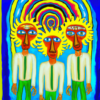The Brothers Karamazov is a complex and thought-provoking novel that delves into the depths of human psychology, ethics, and spirituality. One of the most intriguing aspects of the novel is how the three main characters – Ivan, Dmitry, and Alyosha – represent different facets of the human psyche. For example, Freud’s concepts of the id, ego, and superego can be applied to these characters.
First, let’s define these terms. According to Freud, the id represents our most primitive and instinctual desires, such as hunger, thirst, and sexual impulses. The ego is the rational, logical part of the psyche that tries to balance these desires with the demands of reality. Finally, the superego represents our internalized moral values and societal norms.
Dmitry Karamazov can be viewed as the id in the story. He is impulsive, passionate, and driven by his desires, particularly his desire for Grushenka. His actions throughout the novel, including his violent outbursts and impulsive decision-making, reflect the unchecked desires of the id. Mitya often refers to this as the Karamazov way of living – the insect that lives in all of us.
On the other hand, Ivan Karamazov can be seen as representing the ego in the novel. He is the most rational and logical of the three brothers and is often seen grappling with ethical and philosophical questions. His famous “Grand Inquisitor” chapter illustrates this perfectly, as he presents a logical argument against the idea of a benevolent God. Ivan’s struggle to reconcile his intellect with his emotions is a central theme of the novel.
Alyosha Karamazov can be seen as representing the superego in the novel. He is deeply moral, compassionate, and guided by his faith. Alyosha is often seen as a mediator between Ivan and Dmitry, attempting to balance their conflicting desires and beliefs. But for Alyosha, while he is often seen as embodying the superego, it’s worth noting that his character is more complex than a simple moral authority. He is deeply compassionate and empathetic and often seeks to understand and forgive those who have committed wrongs. This suggests that his role in the novel is not simply to act as a judge or arbiter of morality, but to embody a more holistic approach to ethics that takes into account the complexities of human behavior and motivation.
We should also note that the id is big among the Karamazov family. Apart from the passionate Dmitry, we can also see Smerdyakov and Fyodor Karamazov as representing different aspects of the id. Fyodor Karamazov is driven purely by his base instincts and desires, indulging in his vices without any regard for the consequences or morality. Smerdyakov, on the other hand, is more calculated and manipulative in his actions, using his intelligence and cunning to achieve his own ends. But behind this intellectual veil lies primitive instincts that will have an effect on all the others in the book.
Of course, it is worth noting that Freud’s theory of the id, ego, and superego is not a perfect fit for the characters of The Brothers Karamazov, as it is a complex and multifaceted novel that defies easy categorization. However, viewing the characters through this lens can provide insight into their motivations and actions throughout the story. By viewing the characters in The Brothers Karamazov as Dmitry embodying the passionate id, Ivan representing the logical ego, and Alyosha exemplifying the moral superego it might be easier to remember their main urges in life.
